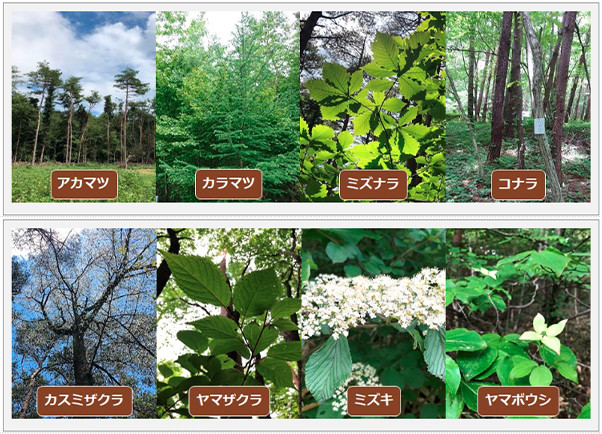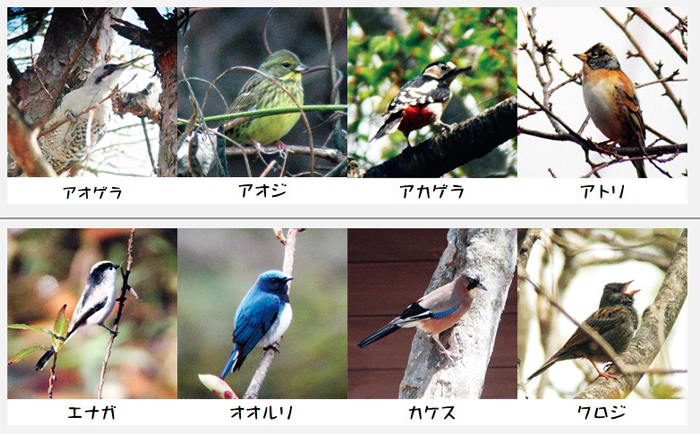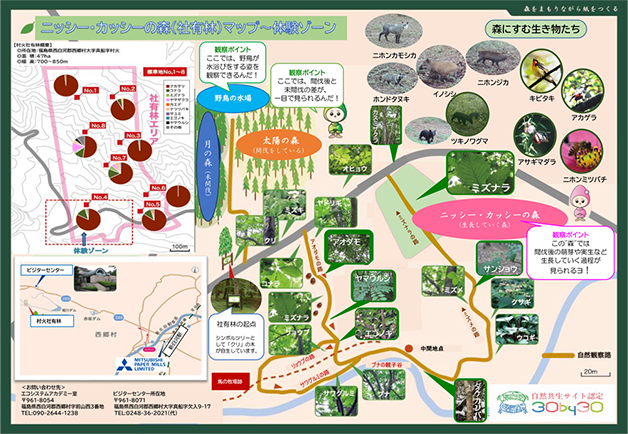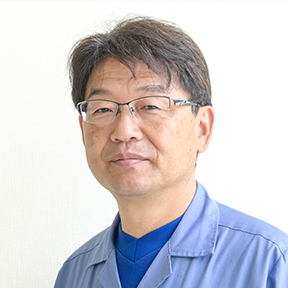2025.02.20

Treasure Trove of Diverse Life!
A forest owned by Mitsubishi Paper Mills Limited has been designated as a Nationally Certified
Sustainably Managed Natural Site by the Ministry of the Environment.

Murabi Forest is located in the Murabi District of Nishigo Village in Fukushima Prefecture and owned by Mitsubishi Paper Mills Limited. It is rich in diverse life, including wild boars, Japanese deer, Japanese hares, Japanese raccoon dogs, meadow buntings, bull-headed shrikes, and 371 species of plants. This forest has been recognized as an area with biodiversity and designated as a Nationally Certified Sustainably Managed Natural Site by the Ministry of the Environment.
Home to Plants and Birds Listed on Fukushima Prefecture’s Red List
Nationally Certified Sustainably Managed Natural Sites refer to areas where biodiversity is conserved through various initiatives undertaken by businesses, private organizations, individuals, and local governments.
The Murabi Company Forest serves as a platform for the Mitsubishi Paper Mills Group’s sustainability promotion activities, such as biodiversity conservation efforts and the Ecosystem Academy, which provides hands-on forest environmental education programs. The certification was awarded in recognition of such extensive initiatives undertaken by the Group. Hiroyuki Tamura, Director of the Ecosystem Academy Division in the General Affairs Department, is a key figure in these activities. He explains the Murabi Company Forest as follows.
“The Murabi Company Forest is located in the Kashi Plateau at an altitude of around 700 to 850 meters, in the basin of the Hokkawa River, a tributary of the Abukuma River. The area lies in the Category 2 Special Zone of Nikko National Park. Situated at the climate boundary between the snowy Japan Sea side and the Pacific Ocean side, the region has a rare ecosystem with the characteristics of both. This area was originally a natural broadleaf forest of various species including Mongolian oak and chestnut trees. From the Meiji period (1868 to 1912) through the end of World War II, the land was used as part of the nation’s military horse pastures. After the war, in the 1950s to 1960s, Mitsubishi Paper Mills Limited planted Japanese red pine trees for the production of pulp. Then, due to the company’s business reorganization, the trees planted in this area were no longer used, and were left unlogged for about 60 years. In 2010, in response to societal demand, the area began to be reused as a site for hands-on environmental education programs.”

Plants found in the Nissy-Kassy Forest
In the Murabi Company Forest, 371 species of plants (169 woody species and 202 herbaceous species) have been identified, primarily consisting of Japanese red pine plantations, natural cedar forests, riparian forests, Japanese red pine and Mongolian oak-mixed forests, and Mongolian oak forests. Among them are nine species listed on Fukushima Prefecture's Red List (a list of endangered species).

Wild birds found in the Nissy-Kassy Forest (Photo provided by the Shirakawa Chapter of the Wild Bird Society of Japan)
The Murabi Company Forest is also home to diverse wildlife, with 16 species of birds—including nine on Fukushima Prefecture’s Red List—having been found. Mammals such as wild boars, Japanese deer, Japanese hares, and Japanese raccoon dogs have also been sighted by trail cameras. In addition, soil animals (ground-dwelling animals) have been identified, with 596 individual animals in 2021, 373 in 2022, and 718 in 2023.
Engaging in Hands-on Environmental Education Initiatives for over 10 Years
In the Ecosystem Academy activities, the Mitsubishi Paper Mills Group has been providing programs such as forest and nature observation; forestry experiences including planting, cultivating, and measuring trees; and papermaking and other crafting workshops to its business stakeholders, such as employees, shareholders, customers, and children in the communities. Through these activities, the Group is committed to raising awareness regarding the importance of biodiversity while enhancing its corporate value.
“We divide the company-owned forest into the Experience Zone and the Nature Zone. The Experience Zone has areas designated for different purposes. Sun Forest is cleared of underbrush and thinned to enable forest observations, while Moon Forest is neither cleared of underbrush nor thinned. At the Nissy-Kassy Forest, visitors can experience tree planting and nurturing. It also has the Nature Observation Trails. The surrounding trees are managed accordingly. In addition, to assist with visitors’ forest and nature observations, nameplates with information are attached to major trees along the trails. On the other hand, the Nature Zone is left untouched to allow nature to take its course.”
Note: Nissy and Kassy are the mascot characters of the Ecosystem Academy of Mitsubishi Paper Mills Limited. Nissy is named after Nishigo Village, while Kassy is named after the Kashi Plateau.
“Nissy-Kassy Forest (company-owned forest) map: Experience Zone” from the Ecosystem Academy brochure
Mitsubishi Paper Mills Limited is also a member of the 30by30 Alliance for Biodiversity, an initiative established by Japan’s Ministry of the Environment. The term “30by30” refers to the goal of effectively conserving or protecting at least 30% of the world’s land and marine areas as healthy ecosystems by 2030, a global target under the Kunming-Montreal Global Biodiversity Framework adopted in 2022. To this end, Japanese companies, local governments, and organizations established this coalition of those willing to take action: the 30by30 Alliance for Biodiversity.
“We believe that this certification of the Murabi Company Forest as a Nationally Certified Sustainably Managed Natural Site is thanks to the initiatives that the company has undertaken throughout the decade. We are also delighted to contribute to the surrounding communities. Going forward, we will work to help achieve the sustainable global environment through biodiversity conservation activities and other initiatives under the Mitsubishi Paper Mills Environmental Charter, which is aimed at building a circular society.”
INTERVIEWEE

HIROYUKI TAMURA
Manager of the Ecosystem Academy Division in the General Affairs Department, Corporate Governance Headquarters
Mitsubishi Paper Mills Limited
2-10-14 Ryogoku, Sumida-ku, Tokyo
Founded in 1898, the company develops and sells products that contribute to the realization of a safe and comfortable sustainable society across a wide range of fields, including non-woven fabrics used as water treatment membrane substrates and filters, electronics, and medical and healthcare. In addition, it promotes the procurement of wood from appropriately-managed forests (FSC-certified material), develops pulp-based products and plastic-free products, and creates unique paper products leveraging its papermaking and coating technologies cultivated through the printing and information paper business.
